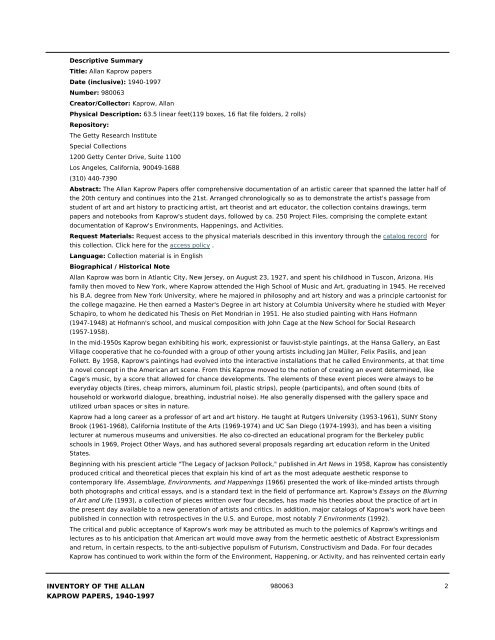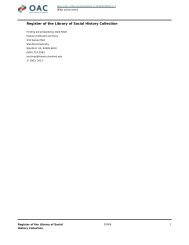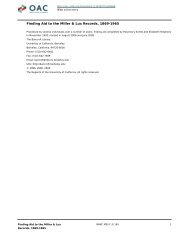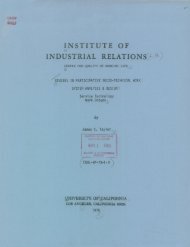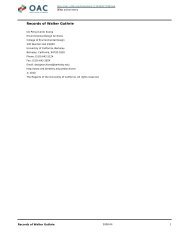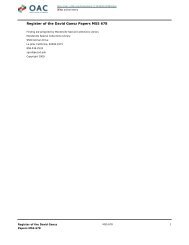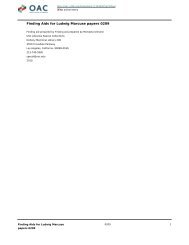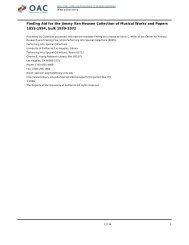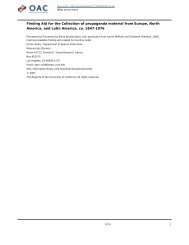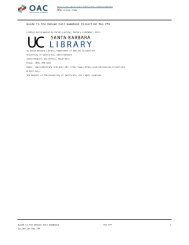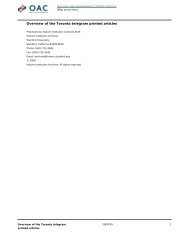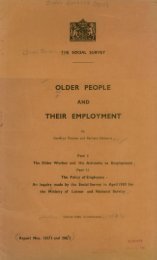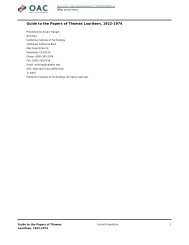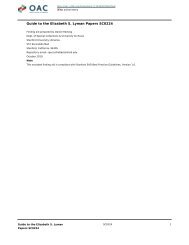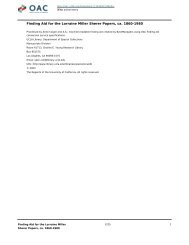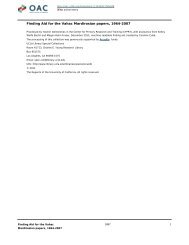inventory of the allan kaprow papers, 1940-1997 - Calisphere
inventory of the allan kaprow papers, 1940-1997 - Calisphere
inventory of the allan kaprow papers, 1940-1997 - Calisphere
Create successful ePaper yourself
Turn your PDF publications into a flip-book with our unique Google optimized e-Paper software.
Descriptive Summary<br />
Title: Allan Kaprow <strong>papers</strong><br />
Date (inclusive): <strong>1940</strong>-<strong>1997</strong><br />
Number: 980063<br />
Creator/Collector: Kaprow, Allan<br />
Physical Description: 63.5 linear feet(119 boxes, 16 flat file folders, 2 rolls)<br />
Repository:<br />
The Getty Research Institute<br />
Special Collections<br />
1200 Getty Center Drive, Suite 1100<br />
Los Angeles, California, 90049-1688<br />
(310) 440-7390<br />
Abstract: The Allan Kaprow Papers <strong>of</strong>fer comprehensive documentation <strong>of</strong> an artistic career that spanned <strong>the</strong> latter half <strong>of</strong><br />
<strong>the</strong> 20th century and continues into <strong>the</strong> 21st. Arranged chronologically so as to demonstrate <strong>the</strong> artist's passage from<br />
student <strong>of</strong> art and art history to practicing artist, art <strong>the</strong>orist and art educator, <strong>the</strong> collection contains drawings, term<br />
<strong>papers</strong> and notebooks from Kaprow's student days, followed by ca. 250 Project Files, comprising <strong>the</strong> complete extant<br />
documentation <strong>of</strong> Kaprow's Environments, Happenings, and Activities.<br />
Request Materials: Request access to <strong>the</strong> physical materials described in this <strong>inventory</strong> through <strong>the</strong> catalog record for<br />
this collection. Click here for <strong>the</strong> access policy .<br />
Language: Collection material is in English<br />
Biographical / Historical Note<br />
Allan Kaprow was born in Atlantic City, New Jersey, on August 23, 1927, and spent his childhood in Tuscon, Arizona. His<br />
family <strong>the</strong>n moved to New York, where Kaprow attended <strong>the</strong> High School <strong>of</strong> Music and Art, graduating in 1945. He received<br />
his B.A. degree from New York University, where he majored in philosophy and art history and was a principle cartoonist for<br />
<strong>the</strong> college magazine. He <strong>the</strong>n earned a Master's Degree in art history at Columbia University where he studied with Meyer<br />
Schapiro, to whom he dedicated his Thesis on Piet Mondrian in 1951. He also studied painting with Hans H<strong>of</strong>mann<br />
(1947-1948) at H<strong>of</strong>mann's school, and musical composition with John Cage at <strong>the</strong> New School for Social Research<br />
(1957-1958).<br />
In <strong>the</strong> mid-1950s Kaprow began exhibiting his work, expressionist or fauvist-style paintings, at <strong>the</strong> Hansa Gallery, an East<br />
Village cooperative that he co-founded with a group <strong>of</strong> o<strong>the</strong>r young artists including Jan Müller, Felix Pasilis, and Jean<br />
Follett. By 1958, Kaprow's paintings had evolved into <strong>the</strong> interactive installations that he called Environments, at that time<br />
a novel concept in <strong>the</strong> American art scene. From this Kaprow moved to <strong>the</strong> notion <strong>of</strong> creating an event determined, like<br />
Cage's music, by a score that allowed for chance developments. The elements <strong>of</strong> <strong>the</strong>se event pieces were always to be<br />
everyday objects (tires, cheap mirrors, aluminum foil, plastic strips), people (participants), and <strong>of</strong>ten sound (bits <strong>of</strong><br />
household or workworld dialogue, breathing, industrial noise). He also generally dispensed with <strong>the</strong> gallery space and<br />
utilized urban spaces or sites in nature.<br />
Kaprow had a long career as a pr<strong>of</strong>essor <strong>of</strong> art and art history. He taught at Rutgers University (1953-1961), SUNY Stony<br />
Brook (1961-1968), California Institute <strong>of</strong> <strong>the</strong> Arts (1969-1974) and UC San Diego (1974-1993), and has been a visiting<br />
lecturer at numerous museums and universities. He also co-directed an educational program for <strong>the</strong> Berkeley public<br />
schools in 1969, Project O<strong>the</strong>r Ways, and has authored several proposals regarding art education reform in <strong>the</strong> United<br />
States.<br />
Beginning with his prescient article "The Legacy <strong>of</strong> Jackson Pollock," published in Art News in 1958, Kaprow has consistently<br />
produced critical and <strong>the</strong>oretical pieces that explain his kind <strong>of</strong> art as <strong>the</strong> most adequate aes<strong>the</strong>tic response to<br />
contemporary life. Assemblage, Environments, and Happenings (1966) presented <strong>the</strong> work <strong>of</strong> like-minded artists through<br />
both photographs and critical essays, and is a standard text in <strong>the</strong> field <strong>of</strong> performance art. Kaprow's Essays on <strong>the</strong> Blurring<br />
<strong>of</strong> Art and Life (1993), a collection <strong>of</strong> pieces written over four decades, has made his <strong>the</strong>ories about <strong>the</strong> practice <strong>of</strong> art in<br />
<strong>the</strong> present day available to a new generation <strong>of</strong> artists and critics. In addition, major catalogs <strong>of</strong> Kaprow's work have been<br />
published in connection with retrospectives in <strong>the</strong> U.S. and Europe, most notably 7 Environments (1992).<br />
The critical and public acceptance <strong>of</strong> Kaprow's work may be attributed as much to <strong>the</strong> polemics <strong>of</strong> Kaprow's writings and<br />
lectures as to his anticipation that American art would move away from <strong>the</strong> hermetic aes<strong>the</strong>tic <strong>of</strong> Abstract Expressionism<br />
and return, in certain respects, to <strong>the</strong> anti-subjective populism <strong>of</strong> Futurism, Constructivism and Dada. For four decades<br />
Kaprow has continued to work within <strong>the</strong> form <strong>of</strong> <strong>the</strong> Environment, Happening, or Activity, and has reinvented certain early<br />
INVENTORY OF THE ALLAN<br />
KAPROW PAPERS, <strong>1940</strong>-<strong>1997</strong><br />
980063 2


